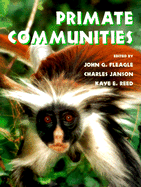Book contents
- Frontmatter
- Contents
- List of contributors
- Preface
- 1 African primate communities: Determinants of structure and threats to survival
- 2 Biomass and use of resources in south and south-east Asian primate communities
- 3 Species coexistence, distribution, and environmental determinants of neotropical primate richness: A community-level zoogeographic analysis
- 4 Primate communities: Madagascar
- 5 Primate diversity
- 6 Phylogenetic and temporal perspectives on primate ecology
- 7 Population density of primates in communities: Differences in community structure
- 8 Body mass, competition and the structure of primate communities
- 9 Convergence and divergence in primate social systems
- 10 Of mice and monkeys: Primates as predictors of mammal community richness
- 11 Comparing communities
- 12 Large-scale patterns of species richness and species range size in anthropoid primates
- 13 The recent evolutionary past of primate communities: Likely environmental impacts during the past three millennia
- 14 Resources and primate community structure
- 15 Effects of subsistence hunting and forest types on the structure of Amazonian primate communities
- 16 Spatial and temporal scales in primate community structure
- 17 Primate communities in Africa: The consequences of long-term evolution or the artifact of recent hunting?
- 18 The future of primate communities: A reflection of the present?
- 19 Concluding remarks
- Systematic index
- Subject index
19 - Concluding remarks
Published online by Cambridge University Press: 21 August 2009
- Frontmatter
- Contents
- List of contributors
- Preface
- 1 African primate communities: Determinants of structure and threats to survival
- 2 Biomass and use of resources in south and south-east Asian primate communities
- 3 Species coexistence, distribution, and environmental determinants of neotropical primate richness: A community-level zoogeographic analysis
- 4 Primate communities: Madagascar
- 5 Primate diversity
- 6 Phylogenetic and temporal perspectives on primate ecology
- 7 Population density of primates in communities: Differences in community structure
- 8 Body mass, competition and the structure of primate communities
- 9 Convergence and divergence in primate social systems
- 10 Of mice and monkeys: Primates as predictors of mammal community richness
- 11 Comparing communities
- 12 Large-scale patterns of species richness and species range size in anthropoid primates
- 13 The recent evolutionary past of primate communities: Likely environmental impacts during the past three millennia
- 14 Resources and primate community structure
- 15 Effects of subsistence hunting and forest types on the structure of Amazonian primate communities
- 16 Spatial and temporal scales in primate community structure
- 17 Primate communities in Africa: The consequences of long-term evolution or the artifact of recent hunting?
- 18 The future of primate communities: A reflection of the present?
- 19 Concluding remarks
- Systematic index
- Subject index
Summary
The goal of this volume was to bring together the efforts of scientists with research interests and experience from many parts of the world to provide a comparative perspective of the primate communities or assemblages from different biogeographical regions. The preceding chapters have taken a wide range of approaches to the study of communities including: (1) broad surveys and analyses of the diversity of communities within individual regions; (2) detailed examinations of the factors that underlie community differences at both a microecological level and a macroecological level; (3) comparative study of the relationship between primate diversity and that of other aspects of the fauna and of the flora; and (4) attempts to put extant communities in a temporal perspective through examination of the history of individual and regional faunas and habitats, as well as attempts to predict changes that primate communities are likely to undergo in the coming years if present patterns of extinction continue.
COMMUNITY DIFFERENCES
In general, most authors seemed to find the differences among communities far more impressive than the overall similarities among communities. The chapters by Kappeler, Reed, and Ganzhorn (chapters 9, 7 and 8 respectively) found significant differences in the body size distributions of primates from different regions both at a regional level and for individual communities. Fleagle & Reed's chapter 6 (see also Fleagle & Reed, 1996) documented differences in the ecological space occupied by individual communities of primates of different regions. Recently, Jernvall & Wright (1998) obtained very similar results using the same technique on a different data set for the primates of entire biogeographic regions.
- Type
- Chapter
- Information
- Primate Communities , pp. 310 - 314Publisher: Cambridge University PressPrint publication year: 1999
- 1
- Cited by

